Check out this video to get some insight into David's personal story which lends to the purpose in his passion to help his clients achieve retirement success.
The world of retirement planning is deeply influenced by the personal experiences and histories of those who navigate it. One such journey, devoid of specific names but rich in lessons and insights, offers a valuable perspective on how early life experiences and family histories can shape professional philosophies in financial planning.

The story begins with a young individual, whose life was significantly impacted by their parents' divorce at the age of two. Raised by a single mother with two other children, this person found solace and guidance in the care of their grandparents. These formative years spent with grandparents in a small town provided foundational life lessons and values.
One grandparent, a dedicated employee at a major company like Sears Roebuck, which narrowly escaped bankruptcy, served as an emblem of resilience and adaptability. This grandparent's profession as a television repairman represented a now-obsolete trade, reflecting a bygone era of technological simplicity and hands-on skill.
The grandparent's investment in company stock, such as Sears, showcased the importance of financial involvement and awareness. This early exposure to stock investments and the significance of pension plans left a profound impact on the young individual, instilling a keen interest in financial planning and investment.
Despite modest means, the grandparent exemplified fiscal prudence and the virtue of saving, owning a home outright, and living within one's means. These characteristics were not just survival strategies but were also foundational principles that would later inform a career in financial planning.
A turning point in this narrative was the grandparent's diagnosis with dementia, leading to significant healthcare expenses that eventually depleted their savings. This transition to relying on Medicaid, a program necessitating minimal personal assets, highlighted the financial vulnerabilities faced in old age.
The family's subsequent struggle with a lien on their property due to Medicaid benefits underscored the complexities and challenges of elder care and its financial implications. This experience, occurring at the onset of the individual’s career in financial planning, was a catalyst for a deeper understanding of elder law and financial protection strategies.
These personal experiences with family financial challenges directly influenced the individual's approach to retirement planning. Observing first-hand the impact of medical expenses and the necessity of financial preparedness in later life, the individual adopted a philosophy emphasizing the protection of capital, its growth, and the generation of sustainable income from it.
This approach was further informed by the mindset of the "depression babies" generation, known for their skepticism towards banks and cautious approach to market investments. This background instilled a sensitivity towards clients who value security and stability in their financial planning.
This narrative, while not tied to a specific individual, illustrates how personal experiences can profoundly shape professional approaches in fields like financial planning. It's a poignant reminder that behind the technical aspects of financial advising are human stories, experiences, and histories that influence and guide the strategies and advice offered by professionals in this field.
In recent times, the financial markets have been characterized by significant volatility and unpredictability, often leading investors to experience what is popularly known as the FOMO (Fear of Missing Out) Market. This term aptly encapsulates the anxiety and urgency that investors feel in the face of rapidly changing market conditions, driven by the fear of missing out on potential gains.
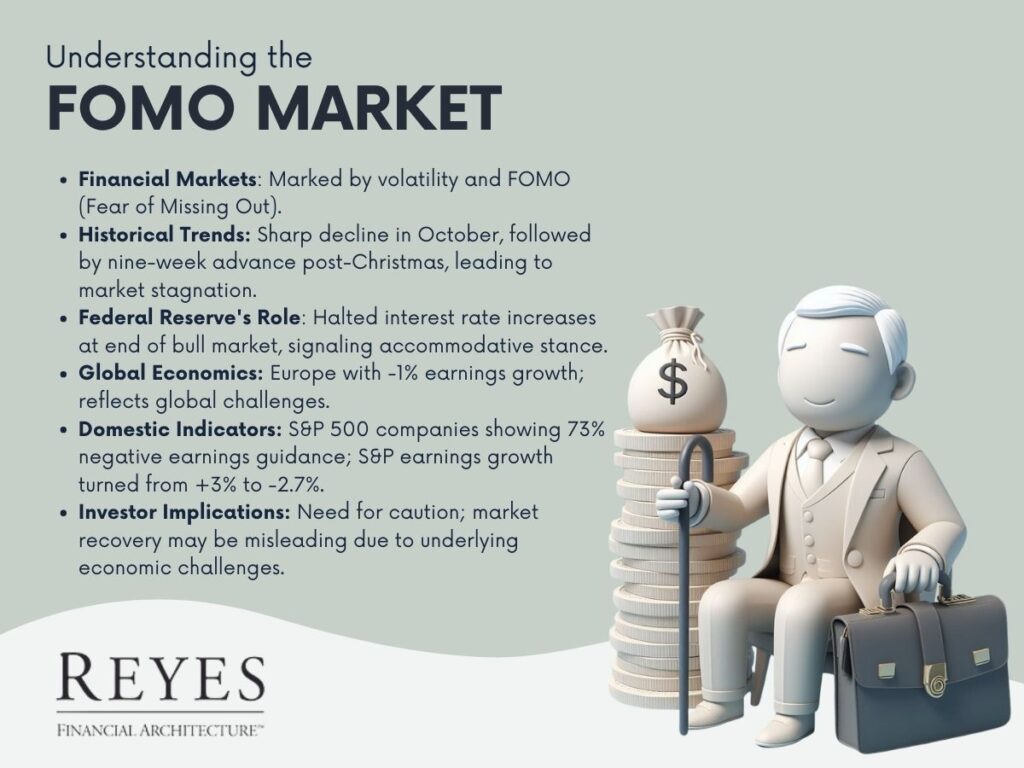
Historically, October of the previous year marked one of the worst performances since 1931, followed by a nine-week continuous advance in the market post-Christmas. This pattern of a sharp decline followed by a rapid ascent has essentially led to a stagnation in market progress over the past year and a half.
The last quarter of the year saw the market in a precarious position, facing challenges from various fronts. However, the Federal Reserve's intervention played a pivotal role in altering this trajectory. The Fed's decision to halt interest rate increases towards the end of a bull market was an unprecedented move, breaking away from traditional monetary policy patterns. This cessation is particularly notable as the market technically entered a bear phase, with a 20% drop from its peak.
The Federal Reserve's actions are crucial in understanding market dynamics. Typically, the Fed raises interest rates to curb inflation and stabilizes the economy, but in this case, they chose a different path. By not increasing rates, the Fed essentially signaled a more accommodative monetary stance, which historically tends to boost market confidence and investment.
Globally, Europe exhibited negative earnings growth in the last year, with a decline of about 1%. This is significant as it reflects broader economic challenges beyond the United States. In the domestic context, nearly all S&P 500 companies have reported their earnings, with a staggering 73% providing negative earnings guidance. This indicates a pessimistic outlook for the future, with expectations of performance being worse than the present.
The S&P earnings growth, which was estimated at 3% in December, has now turned negative, standing at -2.7%. This downturn is particularly stark, considering the record-high earnings growth witnessed in 2018.
These market conditions underscore the need for caution among investors. The rapid recovery of the markets from recent losses might create an illusion of stability and growth. However, the underlying economic indicators suggest otherwise. The volatility is likely to persist, and it's crucial for investors to be prepared for this uncertainty.
Investors are advised to develop a comprehensive understanding of the risks associated with their portfolios. This involves not only a keen awareness of market trends but also a thorough assessment of individual investment objectives, risk tolerance, and long-term financial goals.
In conclusion, navigating the FOMO Market requires a balanced approach, blending caution with opportunity. Understanding the broader economic context, staying informed, and aligning investment strategies with individual risk profiles are key to successfully managing investments in these volatile times. Investors should remain vigilant, adaptable, and informed to make the most out of the opportunities that arise, while safeguarding their investments against potential downturns
Retirement planning is an essential aspect of financial management, yet it remains a challenging endeavor for many. Understanding the nuances of investment, market trends, and effective strategies is vital for a secure retirement.
This blog post explores key principles and strategies to help individuals build a robust retirement plan, emphasizing risk management and financial efficiency.
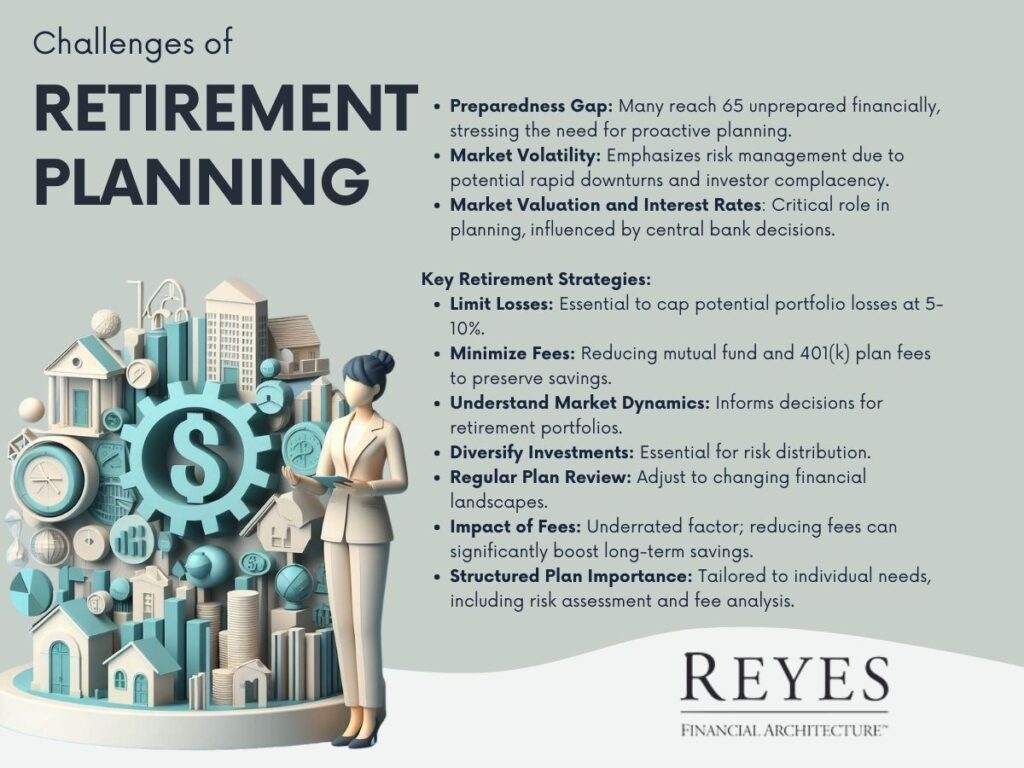
Statistics indicate a concerning trend: a large percentage of individuals reach the age of 65 without adequate financial resources, often relying on family or government support. This underscores the importance of proactive and strategic retirement planning, focusing on creating a guaranteed lifetime income.
Market volatility is a significant factor in retirement planning. Historical trends show substantial market downturns can occur rapidly, highlighting the need for a risk-aware investment approach. As time passes since major financial crises, there's a risk of investor complacency. Acknowledging and planning for potential market fluctuations is crucial in safeguarding retirement funds.
The valuation of the market, often influenced by decisions made by central banks like the Federal Reserve, especially regarding interest rates, plays a critical role in retirement planning. Overvaluation of the market and fluctuating earnings projections can impact investment strategies. Recognizing these factors can aid in making informed decisions for retirement portfolios.
To achieve a secure retirement, certain strategies and principles should be considered:
Additional strategies include understanding market dynamics, diversifying investments, and regularly reviewing and adjusting financial plans.
One often overlooked aspect of retirement planning is the impact of fees on long-term savings. Many individuals are unaware of the fees they incur, especially in investment products like mutual funds and employer-sponsored plans such as 401(k)s. Reducing these fees can lead to significant savings over time.
A structured retirement plan is critical. It should include a thorough risk assessment, an analysis of fees, and a comprehensive strategy tailored to individual needs and goals. A well-constructed plan provides clarity and a roadmap for achieving retirement objectives.
Effective retirement planning requires a multifaceted approach, balancing risk management, financial efficiency, and a deep understanding of market conditions. By adopting key strategies and maintaining a focus on long-term goals, individuals can enhance their chances of a financially secure retirement.
The process involves regular review and adaptation to changing circumstances, ensuring that retirement funds are not only accumulated but also protected and optimized for the long haul.
Planning for retirement requires a keen understanding of market trends, interest rates, and other economic indicators. Here, we explore strategies and insights for securing a financially stable retirement, even in the face of potential economic downturns.
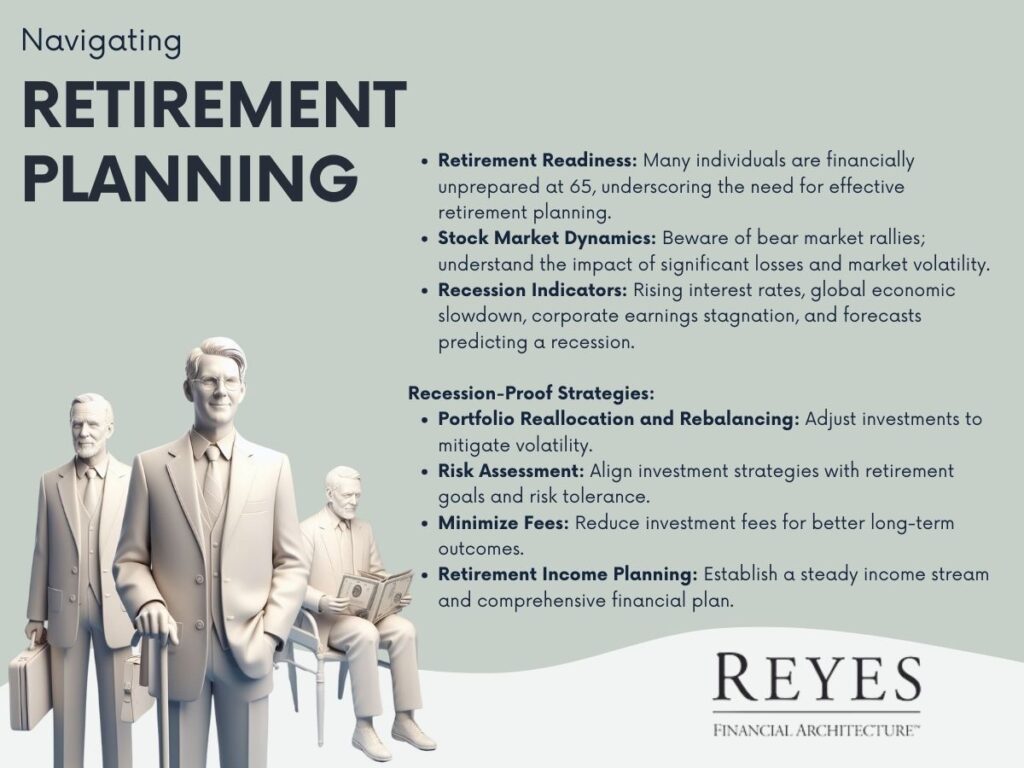
A significant number of individuals reach the age of 65 unprepared financially, often relying on family support or government assistance. This highlights the critical need for effective financial planning to ensure a consistent income throughout retirement.
An important aspect of stock market behavior to recognize is the phenomenon of bear market rallies. These are substantial yet typically temporary recoveries in a declining market, which can mislead investors into believing in the market's stability. The mathematical reality is that a stock falling by 50% and then gaining 50% is still 25% below its original value. This underscores the need to be wary of significant losses and to approach investment decisions with caution.
Several indicators suggest the possibility of an economic recession:
To reduce risks associated with economic downturns, several proactive measures are recommended:
Having a solid retirement plan can provide confidence, even during market downturns, preventing panic and impulsive decision-making.
The complexities of retirement planning, especially in uncertain economic times, make professional advice invaluable. Tailored retirement strategies, responsive to individual needs and economic conditions, are critical for achieving financial security in retirement.
Achieving a secure retirement amidst economic uncertainties is challenging but attainable with the right approach. Being informed about market dynamics, recognizing economic indicators, and taking strategic actions to protect retirement funds are integral to successful retirement planning. These insights offer guidance for individuals seeking to build a resilient and secure retirement plan, regardless of economic fluctuations.
https://youtu.be/tYioyLxbNTI
Take a minute to watch this video for important information on long-term care, a topic everyone needs to be ahead of.
Long-term care (LTC) is a critical aspect of health and personal care that affects a significant portion of the population. Statistics indicate a high probability—around 70%—that an individual or their spouse will require long-term care at some point. This statistic underscores the importance of understanding what long-term care entails, its costs, and how to prepare for it.
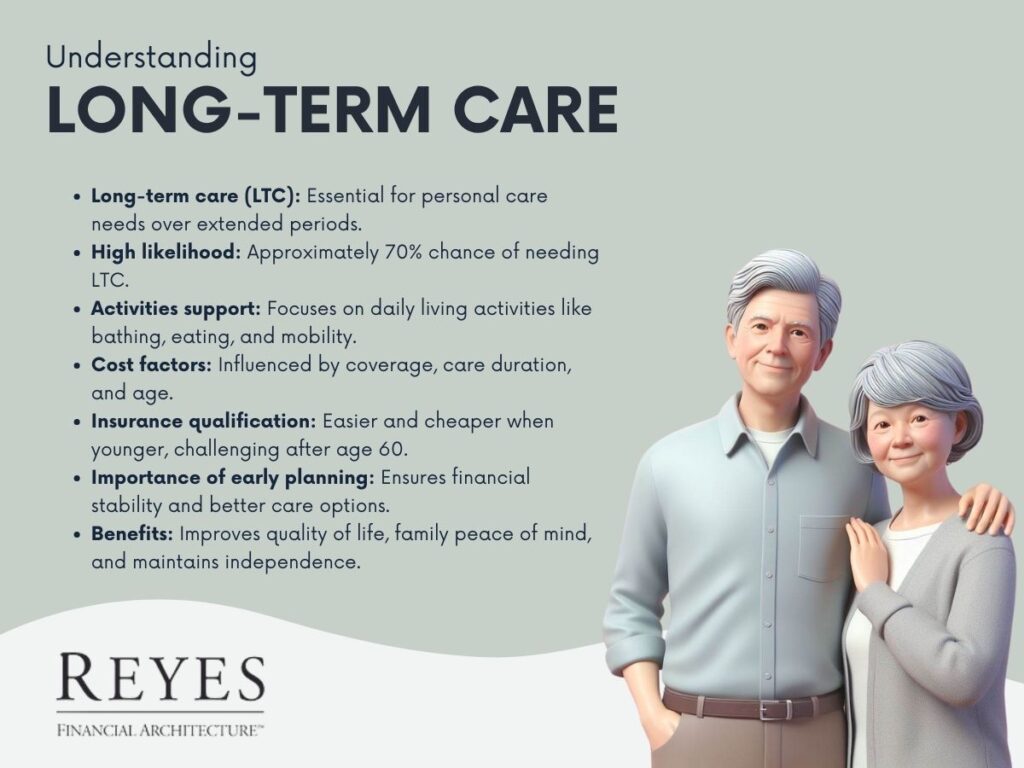
Long-term care refers to a variety of services and supports tailored to meet an individual’s personal care needs over an extended period. Contrary to common misconceptions, most long-term care is not medical in nature. Instead, it predominantly involves assistance with everyday activities crucial for daily living.
Activities of Daily Living, or ADLs, are fundamental tasks that most people perform daily without assistance. These include:
Instrumental Activities of Daily Living, or IADLs, are tasks that are somewhat more complex than ADLs and are essential for independent living. These include:
The cost of long-term care can vary significantly based on several factors:
The initial premium level for long-term care insurance tends to increase with the age of the applicant. Younger individuals typically face lower premiums, highlighting the advantage of planning for long-term care early.
Qualifying for long-term care insurance becomes more challenging with age. Statistics show that 1 in 4 applicants between the ages of 60 and 69 do not qualify for such insurance. This statistic is a stark reminder of the importance of early planning.
Given the high likelihood of needing long-term care and the associated challenges and costs, it is crucial to understand the options and prepare adequately. This preparation is not just a personal matter but also a significant consideration for families.
Understanding and preparing for long-term care is a critical aspect of life planning. Given the high probability of needing such care, it’s prudent to start planning early. This includes understanding what long-term care entails, evaluating insurance options, and considering personal and family needs. By taking proactive steps today, individuals can ensure they have the support and resources they need to maintain their quality of life and independence in the future.
In today's rapidly evolving financial landscape, it's crucial to stay informed and vigilant about the state of the markets. Recently, an expert provided valuable insights on the current state of the market, emphasizing the unprecedented volatility that has gripped the financial world. In this article, we will delve into the reasons behind this cautionary stance and explore the factors contributing to the current market turmoil.
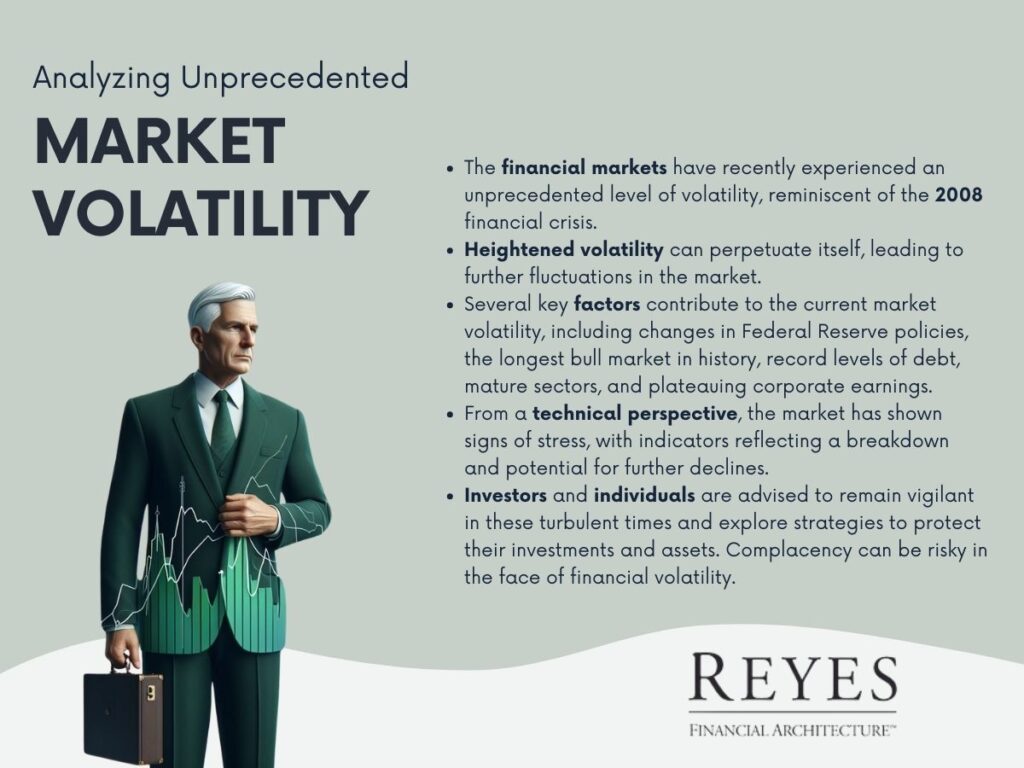
As noted, the financial markets have experienced an unusually high level of volatility in recent times, reminiscent of the tumultuous days of the 2008 financial crisis. This heightened level of market turbulence has not been witnessed since October 2008 and even 2010 came close to matching the current instability.
The adage that "volatility begets volatility" holds true in the financial world. When the market experiences significant fluctuations, it tends to perpetuate this trend. Over the last decade, investors grew accustomed to relative stability, which may have bred complacency. However, the current situation signals a shift in the market dynamics.
Several factors contribute to the heightened volatility observed in today's market:
From a technical perspective, the market has shown signs of stress not seen since 2008 and 2011, with indicators reflecting a breakdown. The S&P 500 is currently hovering around the 2600 level, reflecting a 10% drop from its peak. If the market breaks through this level, it could potentially decline to around 2,300, marking a 20% decline.
In conclusion, the recent market turbulence serves as a stark reminder that complacency in the face of financial volatility can be perilous. The combination of factors such as shifting Federal Reserve policies, an extended bull market, mounting debt levels, and plateauing corporate earnings has created a climate of uncertainty in the financial markets.
Investors and individuals alike would be wise to remain vigilant in these turbulent times. As market experts aptly put it, it's not the time to be complacent. Exploring strategies to protect investments and assets during these uncertain times may prove to be a prudent course of action.